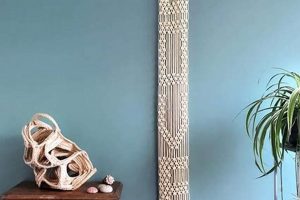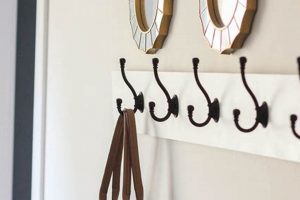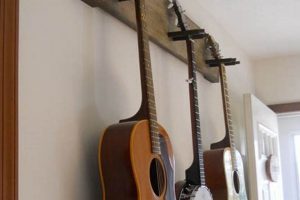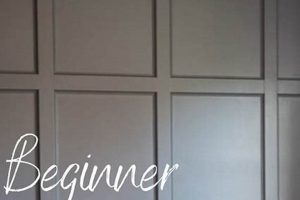Creating artwork directly on a wall surface through individual effort constitutes a significant form of decorative expression. Such endeavors often involve painting, stenciling, or employing adhesive materials to apply designs. These personalized artistic statements transform interior spaces, reflecting the creator’s aesthetic preferences and technical skills. For example, a bedroom might feature hand-painted floral patterns, while a living room could showcase geometric shapes applied with stencils.
This approach to interior design offers several advantages. It allows for complete customization, enabling individuals to tailor artwork to specific room dimensions and color schemes. The process can be a cost-effective alternative to purchasing pre-made art pieces, particularly for large-scale installations. Historically, wall paintings and murals have served as powerful forms of communication and decoration, evident in ancient civilizations and continuing through contemporary art movements. The ability to personally execute these projects fosters a sense of ownership and creative fulfillment.
The subsequent sections will explore specific techniques, material considerations, and design principles relevant to successfully executing artistic features on walls. Guidance on surface preparation, design planning, and the application of various mediums will be provided. This information is intended to equip individuals with the knowledge and skills necessary to realize their envisioned wall art projects.
Guidance for Personalized Wall Art Projects
The following recommendations aim to optimize the execution of personalized wall art projects, promoting aesthetically pleasing and durable results. Careful adherence to these principles mitigates potential complications and enhances the overall quality of the finished work.
Tip 1: Surface Preparation is Paramount: Prior to any application, ensure the wall surface is clean, dry, and free from imperfections. Fill any holes or cracks with appropriate patching compounds and sand smooth. Apply a primer compatible with the intended painting medium. Inadequate preparation compromises adhesion and aesthetic appeal.
Tip 2: Thorough Design Planning: Develop a comprehensive design plan before commencing the artistic process. This includes precise measurements, color palette selection, and the creation of scaled sketches or digital mock-ups. Such planning minimizes errors and ensures accurate representation of the intended outcome.
Tip 3: Stencil Application Techniques: When employing stencils, secure them firmly to the wall surface using appropriate adhesives. Apply paint in thin, even coats using a stencil brush or sponge, minimizing the risk of bleeding. Allow each coat to dry completely before applying subsequent layers.
Tip 4: Utilize Projectors for Complex Designs: For intricate or large-scale designs, consider using a projector to transfer the image onto the wall surface. Trace the projected image lightly with a pencil before painting. This technique ensures accurate proportions and reduces the likelihood of significant errors.
Tip 5: Select Appropriate Painting Mediums: Choose painting mediums based on the desired aesthetic and the wall surface material. Acrylic paints are generally suitable for interior walls due to their durability and ease of application. Consider specialized paints for high-humidity areas or surfaces requiring specific finishes.
Tip 6: Employ Painter’s Tape for Sharp Lines: Utilize high-quality painter’s tape to create clean, crisp lines. Apply the tape carefully, ensuring a secure seal along the edges. Remove the tape slowly and at a 45-degree angle while the paint is still slightly wet to prevent chipping.
Tip 7: Layering Techniques for Depth and Dimension: Introduce depth and dimension by layering different colors and textures. Experiment with techniques such as dry brushing, stippling, and glazing to create visual interest and complexity.
Adherence to these suggestions promotes superior results and facilitates the successful creation of personalized wall art. Diligent planning and execution, combined with appropriate materials, contribute significantly to the longevity and aesthetic impact of the finished piece.
The subsequent section will address common challenges encountered during the creation of personalized wall art and offer solutions for overcoming them. This guidance aims to further empower individuals to confidently undertake their wall art endeavors.
1. Design Complexity
The degree of intricacy in a chosen design presents a significant determinant in the feasibility and resource requirements of a personalized wall art project. An accurate assessment of design complexity relative to available skills and time is essential for achieving satisfactory results.
- Level of Detail
Increased detail in the design necessitates greater precision and patience. Highly detailed designs may involve intricate line work, complex shading, or multiple layers of color. Attempting overly detailed designs without sufficient experience can lead to frustration and subpar outcomes. Realistic depictions of landscapes or portraits often require a level of artistic skill beyond that of a novice.
- Number of Colors
A design incorporating numerous colors demands careful color mixing, precise application, and a thorough understanding of color theory. Managing a wide palette can be time-consuming and may require specialized tools such as palettes and brushes. The potential for color bleeding and unintended mixing increases with the number of colors used, impacting the final aesthetic.
- Geometric Precision
Designs based on geometric shapes and patterns require accurate measurements and precise execution. Imperfections in line straightness, angle accuracy, or shape consistency become readily apparent, detracting from the overall visual appeal. Tools such as rulers, protractors, and levels are essential for maintaining geometric precision.
- Freehand vs. Stenciled Elements
The ratio of freehand elements to stenciled elements directly impacts the skill level required. Predominantly freehand designs demand confident brush control and artistic flair. Stenciled designs, while offering greater precision for repetitive elements, can be time-consuming to create and apply, and may limit design flexibility. A balance between the two approaches may be optimal for many projects.
In conclusion, the successful integration of an intended design into a personalized wall art endeavor is contingent upon a realistic appraisal of the aforementioned facets of design complexity. A design that is thoughtfully scaled to the available resources and skill level will yield a more satisfying and sustainable outcome.
2. Surface Preparation
In the context of personalized wall art projects, surface preparation dictates the quality and longevity of the artistic application. It is a foundational step, establishing the necessary conditions for the subsequent layers of paint, adhesive, or other artistic media to properly adhere to the wall. The absence of adequate preparation directly causes compromised visual aesthetics and diminished durability. For example, applying paint to a dusty or greasy wall surface results in poor adhesion, leading to peeling, bubbling, or an uneven finish. This necessity also applies to surfaces previously adorned with wallpaper. Removing remnants and ensuring a smooth, clean canvas prevents imperfections from telegraphing through the artwork. Therefore, surface preparation is not merely a preliminary step; it’s an integral component influencing the art’s ultimate impact and resilience.
Effective surface preparation typically involves several sequential actions. First, a thorough cleaning to remove dirt, dust, grease, and any loose particles is imperative. This may entail washing the wall with a mild detergent solution, followed by rinsing and allowing it to dry completely. Next, any imperfections, such as holes, cracks, or uneven textures, must be addressed. Filling these with patching compound, sanding smooth, and spot-priming ensures a uniform surface. Finally, the application of a primer designed for the specific wall material and intended paint type promotes optimal adhesion and color consistency. Neglecting any of these steps jeopardizes the entire artistic endeavor, highlighting the practical significance of this phase. For instance, failing to prime a porous drywall surface can result in the paint being absorbed unevenly, requiring multiple coats and potentially altering the intended color.
In summary, proper surface preparation directly affects both the aesthetic appeal and durability of wall art. It mitigates the risk of premature failure, such as peeling or cracking, thereby preserving the artistic investment. While often perceived as a tedious preliminary task, its importance cannot be overstated. It lays the groundwork for a successful and enduring artistic expression. Challenges related to surface preparation, such as dealing with textured walls or removing stubborn wallpaper residue, require specific techniques and careful attention to detail. Addressing these issues proactively ensures a smoother creative process and a more rewarding final product.
3. Material Selection
The choice of materials exerts a direct influence on the aesthetic quality, durability, and ease of execution in a do-it-yourself wall mural project. The relationship is causal: inappropriate material selection leads to compromised results, while judicious choices facilitate the intended artistic expression. For example, selecting a low-quality paint lacking sufficient pigment density results in faded or uneven color coverage, undermining the visual impact of the mural. Conversely, using a high-quality, durable paint specifically formulated for interior walls enhances the mural’s vibrancy and resistance to wear and tear. The importance of material selection is therefore paramount. It forms a critical link between the initial design concept and the tangible realization of the wall mural.
Practical significance is evident in numerous areas. For instance, when creating a mural in a high-humidity environment, such as a bathroom, moisture-resistant paints become essential to prevent mold growth and paint degradation. Similarly, selecting appropriate adhesives for applying stencils or textured elements ensures these components remain securely affixed to the wall surface. The application technique itself often dictates material choices. Airbrushing, for example, necessitates the use of specialized airbrush paints with specific viscosity characteristics. Furthermore, cost considerations often factor into material selection, but prioritizing long-term durability and visual quality over immediate cost savings typically proves more economical in the long run. Selecting pre-tinted paints minimizes potential issues from using a non-tinted paint that is low quality.
In summary, material selection represents a foundational element in the creation of successful wall murals. Understanding the properties and compatibility of different materials directly contributes to the longevity, aesthetic appeal, and overall success of the project. Challenges stemming from inappropriate material choices can be mitigated through careful planning and informed decision-making, ensuring the final outcome aligns with the intended artistic vision. This deliberate approach links directly to broader themes of sustainable practices and value creation within the realm of personalized home decor. Future discussions of stencils and freehand may involve using different materials based on surface.
4. Technique Mastery
Technique mastery forms a critical determinant of success in the creation of personalized wall murals. The level of skill attained in various artistic techniques directly influences the quality, precision, and overall aesthetic impact of the finished work. Insufficient technique proficiency frequently results in compromised visual appeal, inaccurate execution of the design, and increased project duration. The relationship between technique mastery and the realized wall mural is thus causal. For instance, a lack of skill in blending paints can lead to harsh color transitions and a less polished appearance. Conversely, demonstrating competency in techniques such as layering, shading, and perspective can elevate a wall mural from a basic application to a sophisticated work of art. Proper brush control is also paramount.
The practical significance of technique mastery manifests across various facets of the project. In stencil application, precise control over the brush or sponge prevents paint bleed and ensures clean, crisp lines. For freehand designs, mastery of linework and perspective allows for accurate portrayal of intricate details and the creation of depth and dimension. The choice of technique itself depends on the design. Trompe-l’oeil, a technique requiring advanced skills in perspective and shading, creates realistic illusions of depth and space, effectively transforming a flat wall into a three-dimensional scene. Similarly, the marbling technique, when skillfully executed, produces convincing replicas of natural stone patterns, adding elegance and sophistication to the interior space. All techniques create different styles.
In summary, the attainment of technique mastery proves indispensable for producing high-quality wall murals. It directly affects the precision, visual impact, and overall success of the undertaking. Recognizing this connection allows individuals to prioritize skill development through practice, tutorials, or workshops, ultimately leading to more rewarding and aesthetically pleasing artistic endeavors. The challenge lies in identifying the specific techniques required for a given design and dedicating sufficient time to their mastery. This understanding contributes to the broader appreciation of craftsmanship and artistic skill in the realm of home decor, while fostering creativity.
5. Scale & Proportion
Scale and proportion wield considerable influence over the visual harmony and impact of a wall mural. The dimensions of the mural in relation to the surrounding wall space, furniture, and architectural features significantly affect aesthetic perception. An improperly scaled mural, irrespective of its artistic merit, can disrupt the balance of a room, appearing either overwhelming or insignificantly small. For instance, a large, intricate design executed on a small wall may create a sense of visual clutter and claustrophobia, while a diminutive design on a vast expanse of wall might seem lost and inconsequential. The careful consideration of scale and proportion is thus not merely an aesthetic preference, but a critical design element that influences the overall success of the personalized wall art. Properly implemented it is a design decision that impacts space.
The practical significance of understanding scale and proportion becomes apparent when planning a wall mural. Accurate measurements of the wall space and surrounding elements are essential for creating a scaled representation of the design. This process allows for visualization of the mural’s impact within the room before committing to the actual application. The use of digital design tools or physical mock-ups can further assist in refining the scale and proportion. When working with complex designs, breaking down the composition into smaller, manageable units ensures that individual elements maintain appropriate proportions relative to one another. A mural depicting a cityscape, for example, requires careful attention to the relative sizes of buildings, vehicles, and human figures to create a realistic and visually convincing scene. Moreover, the style of the mural should complement the existing decor and architectural style of the room. A modern, abstract design may clash with a traditionally styled space, while a classic, representational mural might feel out of place in a minimalist setting. Therefore, a successful mural should integrate seamlessly with its environment, enhancing rather than disrupting the overall aesthetic.
In conclusion, scale and proportion represent crucial considerations in the creation of personalized wall murals. These elements directly impact the visual harmony and effectiveness of the artistic expression. While the artistic merit of the design remains paramount, its successful integration into the intended space hinges on a careful evaluation of its scale and proportion. The challenge lies in achieving a delicate balance between the mural’s artistic statement and its integration with the surrounding environment. An awareness of these principles fosters aesthetically pleasing results that contribute positively to the overall ambiance of the space, adding a creative spin.
6. Protective Coating
The application of a protective coating to a completed wall mural establishes a critical defense against environmental factors and physical damage, thereby ensuring the artwork’s longevity and preserving its aesthetic integrity. The absence of such a layer renders the mural vulnerable to degradation caused by moisture, UV radiation, abrasion, and chemical exposure. The decision to apply a protective coating is therefore a pivotal determinant in the mural’s lifespan and continued visual appeal. For instance, a mural situated in a high-traffic area without a protective layer is susceptible to scuff marks, fingerprints, and accidental spills, leading to irreversible damage and eventual degradation of the artistic surface.
Practical implications extend to the ease of maintenance and cleaning. A protective coating creates a non-porous barrier that prevents dirt and stains from penetrating the painted surface, allowing for simple cleaning with mild detergents and water. Various coating options exist, each offering distinct levels of protection and aesthetic finishes. Acrylic varnishes provide excellent UV resistance and durability, while polyurethane coatings offer superior abrasion resistance, making them suitable for high-traffic areas. The choice of coating should align with the specific environmental conditions and intended use of the mural. Furthermore, proper application techniques are essential to avoid streaks, bubbles, or uneven coverage, which could compromise the aesthetic outcome. Matte coatings minimize glare and reflections, while gloss coatings enhance color vibrancy and provide a polished appearance.
In summary, a protective coating represents a necessary investment in the long-term preservation of a wall mural. It mitigates the risk of damage from environmental factors and physical wear, simplifies maintenance, and ultimately enhances the aesthetic appeal of the artwork. The selection of an appropriate coating, coupled with proper application techniques, ensures the mural remains a vibrant and enduring feature of the interior space. Foregoing a protective layer, while seemingly cost-effective in the short term, invariably leads to accelerated degradation and the need for costly repairs or replacements, highlighting the importance of this often overlooked step.
Frequently Asked Questions
The following questions address common concerns and misconceptions surrounding the creation and maintenance of personalized wall art installations. These insights aim to clarify the process and promote successful project outcomes.
Question 1: What constitutes the most significant factor impacting the longevity of a wall mural?
Adequate surface preparation and the application of a protective coating represent the most crucial elements in ensuring the long-term durability of wall art. Proper preparation ensures adhesion, while a protective coating shields against environmental damage.
Question 2: Is professional artistic skill a prerequisite for undertaking a personalized wall art project?
While advanced artistic skills certainly enhance the potential for intricate designs, numerous techniques, such as stenciling and geometric patterns, are accessible to individuals with limited prior experience. Proper planning and patience are essential.
Question 3: What measures mitigate the risk of paint bleeding when using stencils?
Securing the stencil firmly to the wall surface with appropriate adhesives and applying thin, even coats of paint using a stencil brush or sponge significantly reduces the likelihood of paint bleeding.
Question 4: Which paint types are generally recommended for interior wall art?
Acrylic paints are generally suitable for interior walls due to their durability, ease of application, and wide range of available colors and finishes. Specific formulations may be required for high-humidity environments.
Question 5: How does design complexity influence the overall project timeline?
Increased design intricacy directly correlates with an extended project timeline. Intricate designs necessitate more time for planning, execution, and potential revisions.
Question 6: What are the primary benefits of utilizing a projector for transferring designs onto the wall?
Projectors facilitate the accurate transfer of complex or large-scale designs onto the wall surface, ensuring proportional accuracy and reducing the potential for errors during the painting process.
These FAQs provide a foundation for understanding the key elements involved in creating personalized wall art. Addressing these concerns proactively contributes to more successful and rewarding projects.
The subsequent section will offer specific troubleshooting advice for common challenges encountered during the creation process. This guidance aims to equip individuals with the knowledge to overcome obstacles and achieve their desired artistic outcomes.
diy wall mural
This exposition has explored the multifaceted dimensions of diy wall mural projects, from surface preparation and material selection to technique mastery and the application of protective coatings. The importance of meticulous planning, skillful execution, and an understanding of design principles has been consistently emphasized. The goal has been to provide a comprehensive overview of the factors contributing to successful wall art installations.
The creation of personalized wall art represents a significant investment of time, resources, and creative energy. A commitment to quality materials, skilled techniques, and a thoughtful approach to design ensures a lasting visual impact. Individuals undertaking these projects should prioritize careful planning and execution to maximize the potential for a rewarding and enduring artistic expression that enhances their interior spaces.







